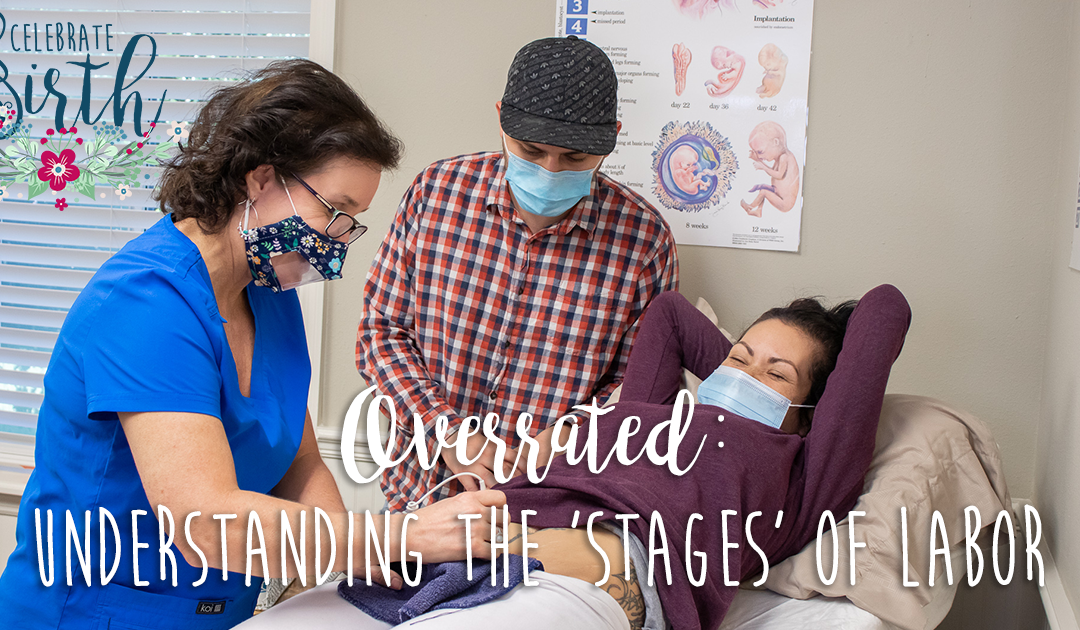Overrated: Understanding the ‘Stages’ of Labor
Did you know that there are four stages of labor? More specifically, did you know that there are different phases that women’s bodies go through during each of the four stages? Today, with the help of our Co-Owner and Midwife Melissa, we are going to break down the stages and phases into real terms.
Every woman’s labor is unique to each birth so each one will progress through these stages at different rates and everyone can experience them differently. While you might speed through one phase of your labor, someone else might work through it at a slower pace. Because of this, the stages of labor are more of a guideline rather than a rule for understanding and preparing for labor. That’s why we created this video to dive deeper into this topic.
First Stage
The first stage of labor is broken down into three phases: latent phase, active phase, and transition phase. The latent phase, which is also referred to as “early labor,” usually starts when your cervix is around 0-3cm dilated. The active phase used to be thought of as the phase when contractions were dilating the cervix from 3 to 8cm, but that has changed over the past several years. Now, many experts consider active labor to begin at 6cm. The last phase, transition, starts when your cervix has progressed to 8-10cm. (Please keep in mind that these numbers are averages and are largely based on first-time moms.) Here is a little more in-depth look into what these phases look like!
– Latent Phase (Early Labor)
The latent phase is usually the longest phase of labor. This is when the thinning and opening of the cervix begins. You may start to feel mild contractions during this stage, but they may be irregular and only last for 30-45 seconds. These contractions are usually pretty tolerable, easy to talk through, and may not require much change in your daily activity. This phase can last for a wide range of time depending on the person. Many moms walk around with a cervix at 1-3cm for weeks prior to labor actually beginning, while some see progress in 6-12 hours or less.
– Active Phase
In the active phase, contractions become longer, stronger, and closer together. They usually last around a minute long each and can start to require more focus and concentration to stay relaxed through them. Just like with early labor, the time frame is very unique to each person. A common time span would be anywhere from 3-6 hours, but it could take days as well. This isn’t usual, but it can happen! Keep in mind again that every labor is different.
– Transition Phase
The last phase of the first stage of labor is the transition phase. This is where things become more difficult as contractions are now at their strongest. It is a sign that your baby will soon be here! It can be helpful for moms to focus on that positive thought instead of the pain. (Here are a few other ways we help manage the pain of labor.)
Second Stage
Once your cervix has fully dilated, it will be time to start pushing. This is the second stage of labor. Once again, the length of this stage can vary depending on certain factors like the position of your baby, its size, and whether or not this is your first birth. The average time frame for first-time moms in this stage is around 2 hours. Once your baby has moved all the way down the canal and been pushed completely out into the world, you are ready for the third stage.
Third Stage
The third stage is known as afterbirth. The uterus will continue to contract to push out the placenta. Moms may need to give a few small pushes to help deliver the placenta as well, a relatively easy process that usually takes around 5 to 15 minutes after the baby arrives. (Our staff at Celebrate Birth typically waits to clamp and cut the umbilical cord until after the placenta is delivered.)
Fourth Stage
You might think that labor is now over, but your recovery is an important and final part of the stages. During this time, your uterus will continue to contract in order to shrink back down to its usual size, pre-pregnancy. Nursing right after birth can help your uterus to contract and can also decrease the amount of bleeding, so if you are interested in breastfeeding, we encourage you to do it soon after the birth.
So what does all of this mean? We can learn and study from books about what is ‘supposed to happen,’ but life doesn’t always operate like that. In reality, we are not machines, we are people. Our bodies need what they need when they need it, which is why the stages are not one-size-fits-all when it comes to progressing through labor. The best thing we can do as providers is prepare our families to feel safe, secure, and knowledgeable about the typical sequence of labor so they can understand what to expect when the time comes. Important to remember is that every mother, every baby, and every family will need unique support during this experience – an experience we are honored to be a part of!
To learn more about what happens to your body during labor, consider taking one of the childbirth classes at The Nest!

